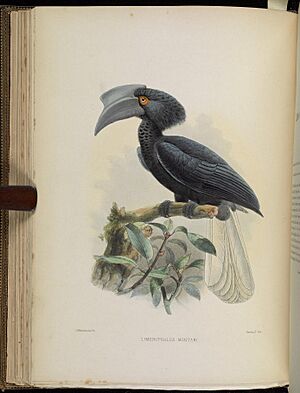Sulu hornbill facts for kids
Quick facts for kids Sulu hornbill |
|
|---|---|
 |
|
| Conservation status | |
| Scientific classification | |
| Genus: |
Anthracoceros
|
| Species: |
montani
|
The Sulu hornbill (Anthracoceros montani) is a special type of hornbill bird. It is also called Montano's hornbill. These birds live only in the Sulu archipelago in the Philippines. Most of them are now found in Tawi-Tawi. Sadly, they might have disappeared from Jolo island because of hunting.
Sulu hornbills live in tropical moist forests. They are in danger because their habitat (their home) is shrinking. People also hunt them for food. Their diet includes fruit, insects, and small lizards.
In 2019, experts believed only 27 adult Sulu hornbills were left in the wild. This makes them one of the most endangered animals on Earth.
What Does the Sulu Hornbill Look Like?
The Sulu hornbill is a large bird. It lives in lowland and mountain forests. It is mostly found on the Sulu Islands. This bird is entirely black. It has a white tail.
It has a long, thick black bill (beak). There is also a black casque (a helmet-like growth) on top of its bill. The skin around its eyes is black and bare. Male Sulu hornbills have pale eyes. Female hornbills have brown eyes. Their casque is also smaller.
The Sulu hornbill is easy to recognize. It is the only hornbill living in its area. Its call sounds like a loud, nasal cackling sound.
Where Do Sulu Hornbills Live?
Sulu hornbills live in old-growth forests. These are often found on mountain slopes. They need large trees for nesting. They sometimes fly over 1 kilometer to find fruit trees.
Their main food is fruit. But they also eat small lizards and some insects.
Why is the Sulu Hornbill Endangered?
The Sulu hornbill is listed as critically endangered. This means it faces a very high risk of disappearing forever. As mentioned, only about 27 adult birds were thought to be alive in 2019. This makes it the most endangered hornbill in the world. It is also one of the most endangered animals overall.
The Sulu hornbill has already disappeared from Jolo island. This happened because of hunting. The remaining birds in Tawi-Tawi are also in danger. Their homes are being destroyed by logging (cutting down trees). Another threat is slash-and-burn farming. This method clears forests for farming.


